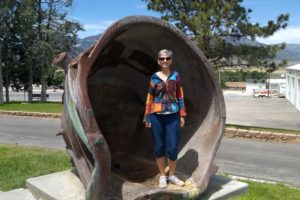The geography and the peoples of this area in North America has an amazing background. Since we learned so much in the 3 museums we visited, I’m first going to concentrate on the geographical changes that happened here since the last Ice Age. Changes in this land will set us up for seeing how people lived here and how they produced the rich farm land that we saw all over the eastern side of the state. Sure wish I had understood more when I took a geology class in college!


Erratic comes from a Latin word that means “to wander.” The Ice Age glaciers that pushed south from Canada carried boulders, rocks, and sand. As the glaciers melted, they left these rocks behind—the original “rolling stone” according to the sign. Sometimes the erratic’s mineral content provides clues suggesting where the erratic originated, but usually the origin remains a mystery.
But what came before the last Ice Age?

The Pembina area has exposures of rocks with fossils from the Cretaceous period (about 65 million to 140 million years ago). During this time, most of the state was covered by seas, and marine life included sharks, bony fish, squids, nautilus-like animals, and giant marine reptiles. Snails, clams, sea urchins, and crabs lived along the shorelines. Large flightless seabirds nested on the water’s edge, while flying reptiles glided across the sky. The weather during this time was much warmer that what we know today.
Before the glaciers were formed when much of what we know today was underwater, North America was split in half by a body of water that ran from the Arctic Ocean to the Gulf of Mexico.

Per Wikipedia, “The Western Interior Seaway (also called the Cretaceous Seaway, the Niobraran Sea, the North American Inland Sea, and the Western Interior Sea) was a large inland sea that existed during the mid- to late Cretaceous period as well as the very early Paleogene, splitting the continent of North America into two landmasses, Laramidia to the west and Appalachia to the east.”


Ice Age
About 2.5 million years ago, the climate began to cool, leading to the last Ice Age when much of the earth’s water was frozen into glaciers.


What caused the cooling of the climate? Here are some suggestions I found when looking online.
- Some articles said it was from changes in the earth’s position in the solar system.
- Other articles said that changes in ocean and atmosphere circulation patterns prompted the Ice Age.
- Then other articles said that volcanic eruptions affected the earth’s climate.
- Finally, sun flares may be responsible for the cooling.
The Ice Age consisted of several cycles of cooling and warming. During these cooling times, glaciers formed and expanded southward into North America (and into Europe and Asia from their northern territories). During the warming periods, the glaciers melted and retreated to the north.
The last glacial period in North America was called the Wisconsian; it began about 100,000 years ago and ended about 10,000 years ago. Most of North Dakota was covered by glaciers during this time. As a result, many of the state’s landforms were formed and river drainages were altered.
According to what I found online, the average global temperature during this last Ice Age was around 45 degrees F, about 11 degrees cooler than the average global temperature today.
As the last glaciers melted, huge lakes were created. One of the largest was glacial Lake Agassiz that covered an area of more than 350,000 square miles as it fluctuating in size and shape over a period of some 5000 years. Some of the lakes still in the area are remnants of glacial Lake Agassiz.

As the glacial lake melted and the glacier moved northward, the Red River was formed, creating the Red River Valley. Be sure to note the states and Canadian provinces that were affected by glacial Lake Agassiz.

This valley is known as the “Breadbasket of the World” because of its productive soil that was formed from organic-rich Lake Agassiz deposits.

We’ll be in the Turtle Mountain area that was mentioned in the last picture after we move from this location, and now we know how the mountain range was formed—it hasn’t had time to form a well-developed drainage system since the Ice Age.

a landscape formed by glaciers

This glacial activity created the beauty, fertility, and economic success of the Rendezvous Region, as well as the rest of the eastern half of the state.



Rendezvous Region

Further west was the Pembina Escarpment, a rise in elevation marking the boundary of Lake Agassiz and the glacier’s edge. West of the escarpment, slightly higher in elevation, grew mixed-grass prairie lands. As rivers cut through these prairies when the glacier melted and moved northward, these rivers left behind valleys and ravines that supported small forests throughout the region.

The most common trees are willow, American elm, green ash, box elder, poplar, and oak. Further west, the Pembina Gorge holds the largest oak woodland in the state.

Because of over trapping, hunting, and loss of habitat, some of these animals were nearly extinct by the late 19th century. While the beaver population has largely recovered, the black bear remains rare, appearing primarily in the Pembina Gorge area.
overview of landscape changes

- The land was once covered by the Western Interior Seaway, and fossilized sea creatures can still be found.
- Then the land was buried beneath a mile of ice forming the Wisconsinan Glacier from the last Ice Age.
- When that glacier melted, it left behind the enormous freshwater Lake Agassiz.
- More than 200 years ago, Native Americans, fur trappers, and traders annually rendezvoused, or gathered, to buy and sell furs and important items in our northeastern corner of North Dakota. They met in a landscape of tall or mixed-grass prairie and forested river valleys. The area was rich in buffalo, elk, beaver, muskrat, and other fur-bearing animals.
- When the Europeans arrived, the landscape began another transformation.
evidence today of glaciers
Some unique landforms characterize the region. Some can be identified from an airplane, others can be seen by car or on foot.

The Edinburg Moraine and the Dahlen Esker are both south of Mountain, North Dakota (in the southwest corner of Pembina County).

Melting water often created streams or rivers deep within a glacier’s icy walls. Sand and gravel carried by these glacial streams gradually built up on the river bed. When the glacier melted, ridges of sand and gravel were left behind. These high ridges, or eskers, can be several miles long. Essentially, they are ancient riverbeds.


The Pembina River and its gorge are one of the most dramatic sights in the region. We were on our way to the gorge and a great hike when I fell and broke my ankle so we can’t show you any pictures of the gorge. It is the longest stretch of unaltered river valley in North Dakota because its rugged terrain protected it from commercial uses.
Sand, gravel, and soil are carried by the rivers to be deposited in the valleys, forming alluvial areas. (Per Wikipedia, “Alluvium is loose, unconsolidated (not cemented together into a solid rock) soil or sediment that has been eroded, reshaped by water in some form, and redeposited in a non-marine setting.”)
giant mammals of the Ice Age







One possibility is that the warming climate ending the Ice Age also reduced the supply of protein-rich flowering plants that supported them.
A second possibility is that as the glacier melted and retreated, these large mammals got stuck in the soft ground/mud and couldn’t escape.
A third possibility is the arrival of humans in North American that led to overhunting. But this overhunting happened so much later than the end of the Ice Age that I find this explanation curious.
next
Now that we’ve covered the geological changes, let’s start looking at how the area changed as people started populating the area.




